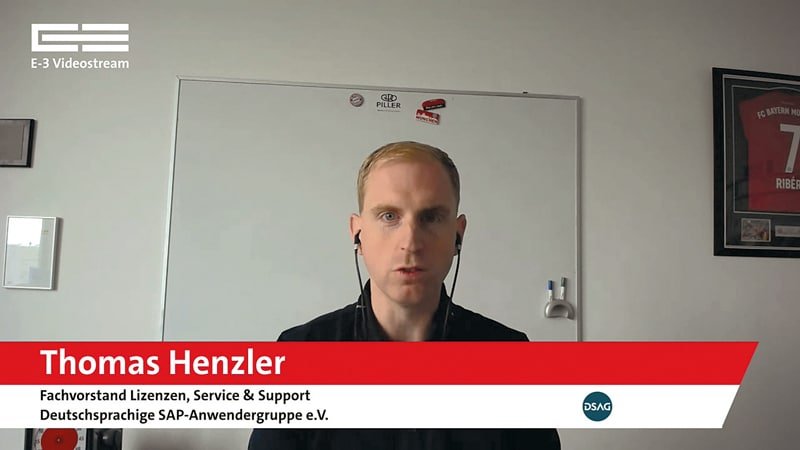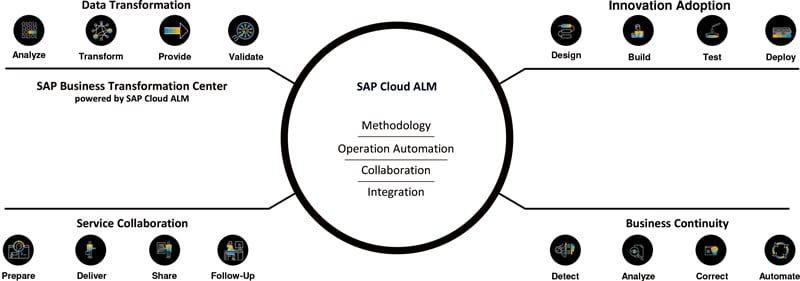Transformation of the SAP Basis


Business administration, organization and technology
In past years, there was a stringent separation between technology, ERP architecture, and SAP Basis on the one hand, and applications, algorithms, and business processes on the other. At the beginning of each year, the SAP user association DSAG holds the well-known Technology Days, where, among others, the CCC and CCoE managers as well as many basic employees of SAP's existing customers meet. After the summer break, there is the DSAG Annual Congress with strategic and visionary keynotes and a focus on applications and business process management. There more the technicians, at the annual congress more the users from the specialist departments.
At last year's annual congress it was different: Technicians and users did not face each other, but they formed an ERP E2E story. The focus was on Application Lifecycle Management, to the left of which was Business Process Management with products from Signavio, and to the right of which was the basic function of Test Management with a new SAP partner cooperation. SAP calls the whole thing "Business Transformation Suite" and at the DSAG annual congress showed for the first time the breadth and depth of tasks of a future Customer Competence Center (CCC) and Customer Center of Expertise (CCoE).
The new cloud view compared to on-premises is logical: Cloud computing brings upgrades and updates at shorter intervals, so that only automated testing guarantees the stability of SAP's existing ERP systems. SAP's Business Transformation Suite thus becomes a field of activity for SAP Basis and is thus the focus of Application Lifecycle Management, ALM.
"For experienced SAP managers, one thing is certain: Only a well-functioning infrastructure spurs the important SAP applications," also emphasizes Empirius Managing Director Hans Haselbeck on the topic of SAP Basis and automation. "And the more and more extensively smart tools are used to support IT infrastructure tasks or actions simply, highly automated and quickly, the more SAP Basis can concentrate on important application-related tasks or activities. On top of that, this results in benefits for SAP managers. If the SAP infrastructure runs optimally, the applications also run optimally. Automation solutions have been proven to save time and money. Automation solutions also help to better manage personnel problems in the SAP Basis environment."

Knowing what is happening is thus crucial for SAP Basis in the context of a Business Transformation Suite. Many existing SAP customers are therefore asking themselves whether monitoring has now become a discipline in its own right and cannot perhaps be covered by SolMan and ALM. Klaus Kurz of New Relic knows from his professional practice that important components such as application server instances, databases or hosts are located at the infrastructure level - and if problems occur here, it can have an impact on all other business processes. "Observability at infrastructure level provides an overview of the overall state of the system. In this way, errors and their sources can be identified quickly and easily because important information can be forwarded directly, collected centrally and processed further by software," emphasizes the New Relic manager in an E-3 interview, see also following pages of the Cover Story. "In many cases, traditional solutions are already in use, including SAP Solution Manager. One obstacle with such solutions is often the lack of common telemetry data, tools, and dashboards, which means errors have to be fixed manually and also makes it harder to communicate with other teams."
Monitoring
Infrastructure monitoring enables SAP's existing customers to monitor the underlying entities that keep their business processes running. "However, many processes also run on cloud platforms such as Amazon Web Services or Microsoft Azure," explains Klaus Kurz, adding, "Monitoring in the cloud reduces the risk of SAP errors affecting cloud applications and vice versa. It also reduces the risk of something going wrong or data being lost during cloud migrations. Effective infrastructure monitoring, whether on-premises, in the cloud, or in hybrid models, reduces the time it takes IT teams to detect and resolve issues, reducing Mean Time to Detect and Mean Time to Resolve."

Conversion
Accordingly, in the context of S/4 conversion, the operating model and operational management are becoming increasingly important. SAP partner Itesys in Switzerland has moved an existing SAP customer from an AS/400 platform to the cloud and now manages the entire system. "SAP Basis is our DNA," Tanja Schöller of Itesys tells E-3 Magazine. Success stands and falls with the SAP infrastructure, Itesys knows, because SAP Basis forms the foundation for the ERP landscape. The task is to customize an optimally configured and highly available SAP landscape on S/4 on-premises or in the cloud. To achieve this, Itesys operations staff monitor service requests, incidents, request fulfillments and changes.

"SAP Basis is our DNA"
Tanja Schöller, Itesys
Hans Haselbeck has a similar view: "Empirius consistently follows the guideline of providing smart solutions for the SAP infrastructure and basis. This means using mouse clicks to initiate, execute or have executed tasks and actions without programming. So that even non-specialists are enabled to easily and quickly create SAP system copies, for example." According to Hans Haselbeck, it is also true that massive time minimizations for tasks and actions can be achieved by means of stored automation mechanisms. For example, the BlueCopy installation of Empirius only takes around one day and the creation of an SAP system copy with the automation solution takes a few hours instead of several days. "In addition, it is not necessary to set up the creation of one or more SAP system copies as a kind of project," Haselbeck emphasizes. Furthermore, SAP system copies at Empirius always run with the same high process quality.

"Consistently, Empirius follows the guideline of providing smart solutions to the SAP infrastructure and base.
Hans Haselbeck, Empirius
The predominant topic is S/4 conversion, but many existing SAP customers are still using Business Suite 7 with any-DBs (IBM DB2, Oracle, Microsoft, Sybase, MaxDB or Hana); and also many S/4 with the Hana database in their own data centers or with service providers. "And all SAP customers are dealing with the operational issues of cloud, hybrid clouds and on-premises," Hans Haselbeck knows from his professional experience. Early on, Empirius geared its solutions to be able to use SAP system copies for SAP Classic with Any-DBs as well as for S/4 with Hana.
Automation
Why is the automation of SAP Basis tasks important for an existing SAP customer? "In our view, there are two acute challenges in SAP Basis operations that can be ideally countered by automating SAP Basis tasks," explains Nikolas Roggenbauer from Automatics.ai in an E-3 interview. "The shortage of specialists is already strongly noticeable among SAP Basis administrators. Due to retirements, growing parallel projects such as S/4 conversion and a lack of people on the labor market, this situation will worsen significantly in the coming years. Whether it's a shortage of skilled workers, the work-life balance, or freeing up employees for urgently needed projects: By automating SAP Basis operations, employees can be relieved in daily business by completely automating tasks that have to be performed manually on numerous SAP systems and at night or on weekends."

Business Processing
Companies use SAP as a business application for core business processes, as evidenced by the Business Transformation Suite feature. SAP legacy customers often store their most important data, including intellectual property, in SAP systems. This data must be protected from unauthorized access. Due to the drastic increase in the number of cyber attacks, it is therefore essential for companies to keep the security of their SAP systems as high as possible. Automated detection and implementation of new security hotfixes in SAP systems, as well as automated patching of all SAP components, significantly increases system security.
Can the successful SAP SolMan also help here? "We see the SolMan more as a central information platform of selected system information for customers," emphasizes Nikolas Roggenbauer. "However, the SolMan must be continuously maintained in order to keep a clean level of information. In terms of central auditing and management of system configurations, however, it is hardly ever used. The customer wants an automation and management solution for central auditing, configuration management, patch management and importing SAP notes. Automatics offers these functions based on Solution Manager or Landscape Management and can use these two systems as a source of information if required."

"We see SolMan at customers more as a central information platform of selected system information"
Nikolas Roggenbauer, Automatics.ai
So is a limitation to monitoring the SAP infrastructure with Solution Manager sufficient? Klaus Kurz from New Relic adds in the E-3 discussion: "Solution Manager collects the telemetry data of individual SAP tools, logs, events, metrics and traces. When a problem occurs in an SAP system, it can take a long time to identify the problem, assign it, find the root cause and resolve it. This is because telemetry data is not collected and analyzed centrally - this process is done manually. These delays impact uptime, reliability, performance, and usability, and impact the organization's service level objectives and service level agreements for its key business processes. Understanding the performance and overall health of the entire SAP system with a single SAP-friendly integration is the goal of a comprehensive observability solution. Instead of searching for it by hand, the information needed then appears in context on a single dashboard."
Observability
Practice shows that without adequate end-to-end observability, SAP's existing customers have no overview of the performance of their SAP components and their impact on other systems and software. "And in the rare cases where performance data is available, it is costly and time-consuming to compile it manually from various sources," adds the New Relic manager. "To have a comprehensive view anytime, anywhere, a clear, fast, and easy-to-implement observability solution is of great benefit to enterprises." The entire SAP Basis is undergoing a transformation process that also includes the topic of open source. In this process, SAP Basis does not only have to deal with Linux.
"As more and more customers move their SAP workloads to Kubernetes, monitoring becomes increasingly important to ensure that these workloads are running smoothly and to quickly identify and resolve any issues that may arise," Klaus Kurz knows from his professional experience. "Kubernetes monitoring can provide valuable insights into the performance and resource utilization of SAP workloads, helping customers optimize their usage and make more informed decisions about scaling and resource allocation." As a result, a Kubernetes monitoring solution complements the SAP offering by providing workload container monitoring while the SAP solution monitors application and business process tiers.
Open Source
Nikolas Roggenbauer adds to the topic of open source at SAP Basis: "Open source solutions, such as Ansible, are of central importance in the area of automation. It is important here that a holistic process view for operational operations is considered when developing automations. Therefore, in our view, open source solutions still require SAP Basis experts to combine these building blocks into a coherent and stable process. Furthermore, the different framework conditions, such as operating systems, databases, SAP releases, etc., as well as ongoing changes in the system landscape must be taken into account.






